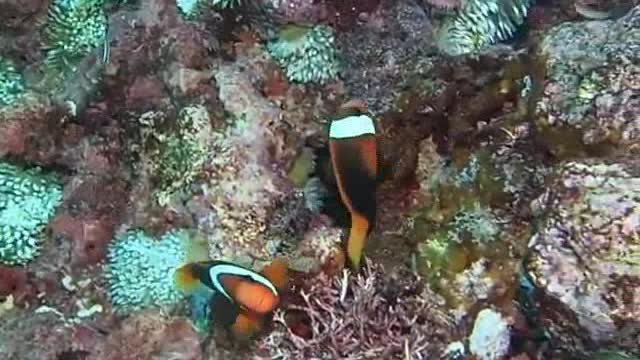Premium Only Content

Diver Explore Fishes Living Inside Coral reefs
Coral reefs are large underwater structures composed of the skeletons of colonial marine invertebrates called coral. The coral species that build reefs are known as hermatypic, or "hard," corals because they extract calcium carbonate from seawater to create a hard, durable exoskeleton that protects their soft, sac-like bodies. Other species of corals that are not involved in reef building are known as “soft” corals. These types of corals are flexible organisms often resembling plants and trees and include species such as sea fans and sea whips, according to the Coral Reef Alliance (CORAL), a nonprofit environmental organization.
Each individual coral is referred to as a polyp. Coral polyps live on the calcium carbonate exoskeletons of their ancestors, adding their own exoskeleton to the existing coral structure. As the centuries pass, the coral reef gradually grows, one tiny exoskeleton at a time, until they become massive features of the marine environment.
Corals are found all over the world's oceans, from the Aleutian Islands off the coast of Alaska to the warm tropical waters of the Caribbean Sea. The biggest coral reefs are found in the clear, shallow waters of the tropics and subtropics. The largest of these coral reef systems, the Great Barrier Reef in Australia, is more than 1,500 miles long (2,400 kilometers).
Scientists have explored only about 20 percent of the ocean's floor, according to the National Oceanic and Atmospheric Administration (NOAA). As such, ocean explorers continue to discover previously unknown coral reefs that have likely existed for hundreds of years.
The lives of coral
There are hundreds of different species of coral, according to CORAL. Coral have a dazzling array of shapes and colors, from round, folded brain corals (named for their resemblance to a human brain) to tall, elegant sea whips and sea fans that look like intricate, vibrantly colored trees or plants.
Corals belong to the phylum cnidaria (pronounced ni-DAR-ee-uh), a group that includes jellyfish, anemones, Portuguese man o' war and several other gelatinous and stinging marine invertebrates.
Corals feed by one of two ways. Some species catch small marine life, like fish and plankton, by using the stinging tentacles on the outer edges of their bodies. Most corals, however, depend on algae called zooxanthellae to provide energy via photosynthesis.
The corals have a symbiotic, or mutually beneficial, relationship with the zooxanthellae, according to the U.S. Environmental Protection Agency (EPA). These algae live inside the coral polyp's body where they photosynthesize to produce energy for themselves and the polyps. The polyps, in turn, provide a home and carbon dioxide for the algae. Additionally, the zooxanthellae provide the coral with their lively colors — most coral polyp bodies are clear and colorless without zooxanthellae.
Some coral species, such as brain coral, are hermaphrodites, which means they produce eggs and sperm at the same time. Sexual reproduction occurs during a mass coral spawning event that, for some species, happens only once a year.
Other species, such as elkhorn coral, are gonochoric, which means they create colonies composed of either all males or all females. Within each coral colony all the polyps will produce only eggs or only sperm. For successful reproduction, the colony must rely on a neighboring colony that produces the other reproductive cell.
-
 1:39:44
1:39:44
HELMET FIRE
3 hours agoDEADROP IS BACK!
47.1K4 -
 10:03
10:03
Tundra Tactical
5 hours ago $4.77 earnedBrandon Herrera Vies Bid for ATF Director!
24.7K3 -
 22:01
22:01
DeVory Darkins
1 day ago $17.90 earnedHakeem Jeffries SHUTS DOWN The View as Matt Gaetz Speaks out
27.8K79 -
 2:02:54
2:02:54
Mally_Mouse
4 hours agoLet's Play!! - Spicy Saturday
17.1K -
 1:33:06
1:33:06
Slightly Offensive
5 hours ago $15.34 earnedAre You Ready for What's Coming Next? | Just Chatting Chill Stream
37.2K16 -
 32:10
32:10
MYLUNCHBREAK CHANNEL PAGE
1 day agoThe Gate of All Nations
92.3K41 -
 13:07
13:07
Sideserf Cake Studio
9 hours ago $1.02 earnedIS THIS THE MOST REALISTIC SUSHI CAKE EVER MADE?
26.9K1 -
 21:08
21:08
Clownfish TV
1 day agoElon Musk Tells WotC to BURN IN HELL for Erasing Gary Gygax from DnD!
21.7K8 -
 48:22
48:22
PMG
5 hours ago $3.90 earned"IRS Whistleblowers Speak Out on Biden Family with Mel K In-Studio"
17.9K9 -
 2:59
2:59
BIG NEM
7 hours agoLost in the Wrong Hood: Who Do I Check In With?
14.3K2